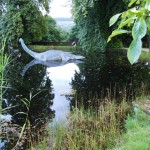The Lоch Ness Monster (Nessie)
The Lоch Ness Monster (Nessie) – is a monster that, as legends have it, inhabits the Scottish lake Loch Ness.
Tradition has it that the first ones who made it known to the world about the mysterious creature in a far away Scottish lake were Roman legionaries who with a sword in hand explored Celtic expanses at the dawn of Christian Era. Locals immortalized in stone all the representatives of Scottish fauna – from deer to mouse. The only stone sculpture Romans could not identify was a queer image of a long-necked giant-sized seal.
The first written mention of a mysterious creature that inhabits the waters of Loch Ness traces back to 565 A.D. In the Life of Saint Columba abbot Jonah spoke about the saint’s triumph over a “water beast” in River Ness. Superior Columba at that time was converting pagan Picts and Scotts into Christianity in his new monastery near the west coast of Scotland. One day he came out to Loch Ness and saw local people bury one of their men. He was mauled and killed when he swam in the lake. He fell victim to Niseag (Gaelic name of the monster). Locals, equipped with pole hooks to keep the monster off, pulled the body of the killed man over to the bank. One of the saint’s disciples thoughtlessly threw himself into the water and began to swim across the narrow channel to bring the floating boat back. When he swam a certain distance from the bank “out of the water rose a strange looking beast alike a gigantic frog but it was not a frog.” This is the beginning of the legend of the Loch Ness Monster.
In spring of 1933 the newspaper “Inverness Courier” for the first time published a detailed narrative of a married couple McKay who came across Nessie and saw it with their own eyes. In that same year alongside the northern shore of the lake a road was paved and trees and shrubs were cut down for a better view on the biggest freshwater pond in Britain. In August of the same year three eyewitnesses noticed roughness on the usually calm Loch Ness Lake. Then a line of several humps began to appear out of the surface of the water, disappear and appear again. They were moving in a wave-like manner like a caterpillar.
Explanations
The majority of the supporters of the monster’s existence believed it to be a long-surviving plesiosaur but during 70 years of “sightings” no corpse of an animal was ever to be found. Sixth century’s reports about sightings of the animal also give rise to doubts. Other explanations were also introduced about the origin of Nessie that do not require the hypothesis about plesiosaurs’ survival to this day.
Explanation 1
In 2005 Neil Clark, the supervising paleontologist of the Museum of Glasgow University, compared the first trustworthy sightings of the monster with the schedule of transportation of traveling circuses on the road to Inverness. And he realized that what local people saw were not pre-historic dinosaurs but swimming elephants.
The scientist came to the conclusion that most of the reports about Nessie go back to 1933 and later years. It is at that very time that in the vicinity of the lake traveling circuses stopped on the road to Inverness. Clark believes that the object of the first sightings of Nessie and the pictures taken was not anything else but swimming elephants. When an elephant swims it puts out of the water the trunk. Also on the surface of the water two “humps” can bee seen – the top of the head and the upper part of the back of the elephant. This picture very much resembles the description and photographs of Nessie. And only after that, as Clark believes, the manager of a circus troupe Bertram Mills (apparently, realizing what stands behind the sightings of the monster) offered a big money reward (₤20,000 or ₤1 million in today’s money) to the person who would catch Nessie for him.
Explanation 2
The Italian seismologist Luigi Piccardi carried out his own research on the shores of the famous Loch and made its results known to the public. In his opinion, the Loch Ness is located along the Great Glen tectonic fault. Therefore, huge waves on the surface of the lake as well as gigantic bubbles rising from its bottom, in the Italian’s opinion, are nothing else but the results of tectonic activity on the surface of the bottom of the lake. All this, says Piccardi, can be accompanied by blow-out of tongues of flame, characteristic sounds resembling muted roar as well as cause small earthquakes which people mistake for the monster.

